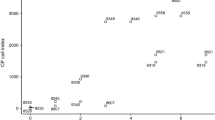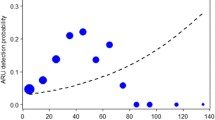Abstract
Monitoring wildlife population trends is critical for the conservation of endangered species and measuring the efficacy of management activities. Recently, passive acoustic monitoring has emerged as a useful wildlife monitoring tool and automatic recorders have been used to detect the presence of gibbons in protected areas of Vietnam. However, these recording devices can be expensive, cumbersome, and difficult to operate in some areas with gibbons. Therefore, inexpensive, lightweight, and easily operated recording devices are needed for wildlife monitoring. In this study, we employed mobile smartphones to detect the presence and distribution, and to estimate the occurrence probability, of the northern yellow-cheeked crested gibbon (Nomascus annamensis) in Dakrong Nature Reserve (405.3 km2), Vietnam. We surveyed gibbons from February to July 2019, during the dry season, at 95 sites that were systematically spaced throughout the nature reserve. We used the software package, RAVEN, to analyze the sound data and to identify gibbon calls. We detected gibbon calls at 39 out of 95 recording sites. With these data and an occupancy model, we estimated, and examined the effects of environmental factors, on the occurrence probability. Assuming a 600 m detection distance, the model-averaged occurrence probability for the nature reserve was 0.44 (SE = 0.06). The area of rich (> 100 m3/ha) and medium (> 200 m3/ha) evergreen forest within 1 km of the recording posts was the most important predictor of, and positively correlated with, occurrence with less occurrence in poor, regrowth forest, plantations, or on bare land. Bioacoustic methods can be potentially used in large-scale gibbon surveys, and the technology is especially attractive given the low cost. Additional work on estimating detection distances and identifying individual gibbon groups using bioacoustics will be useful next steps.



Similar content being viewed by others
Data Availability
The datasets are available from the corresponding author upon request.
References
Brockelman W, Ali R (1987) Methods of surveying and sampling forest primate populations. Primate Conservation in the Tropical Rain Forest, 23–62.
Celis-Murillo A, Deppe JL, Ward MP (2012) Effectiveness and utility of acoustic recordings for surveying tropical birds. J Field Ornithol 83:166–179. https://doi.org/10.1111/j.1557-9263.2012.00366.x
Chesmore ED, Ohya E (2004) Automated identification of field-recorded songs of four British grasshoppers using bioacoustic signal recognition. Bull Entomol Res 94:319–330. https://doi.org/10.1079/ber2004306
Cheyne SM, Gilhooly LJ, Hamard MC et al (2016) Population mapping of gibbons in Kalimantan, Indonesia: Correlates of Gibbon Density and Vegetation across the species range. Endanger Species Res 30:133–143. https://doi.org/10.3354/esr00734
Clink DJ, Hamid Ahmad A, Klinck H (2020) Gibbons aren’t singing in the rain: presence and amount of rainfall influences ape calling behavior in Sabah. Malaysia Scientific Reports 10(1):1282. https://doi.org/10.1038/s41598-020-57976-x
Feng JJ, Cui LW, Ma CY et al (2014) Individuality and stability in male songs of Cao Vit gibbons (Nomascus nasutus) with potential to monitor population dynamics. PLoS ONE 9(5):e96317. https://doi.org/10.1371/journal.pone.0096317
Fonzo MD, Collen B, Mace GM (2013) A new method for identifying rapid decline dynamics in wild vertebrate populations. Ecol Evol 3:2378–2391. https://doi.org/10.1002/ece3.596
Geissmann T (1993) Evolution of communication in gibbons (Hylobatidae). Dissertation, Zürich University.
Geissmann T, Orgeldinger M (2000) The relationship between duet songs and pair bonds in siamangs, Hylobates syndactylus. Anim Behav 60:805–809. https://doi.org/10.1006/anbe.2000.1540
Gray TNE, Phan C, Long B (2010) Modelling species distribution at multiple spatial scales: gibbon habitat preferences in a fragmented landscape. Anim Conserv 13:324–332. https://doi.org/10.1111/j.1469-1795.2010.00351.x
Gray TNE, Nguyen QHA, Nguyen VT (2014) Bayesian occupancy monitoring for Annamite endemic biodiversity in central Vietnam. Biodivers Conserv 23:1541–1550. https://doi.org/10.1007/s10531-014-0685-7
Hilje B, Aide TM (2012) Calling activity of the common tink frog (Diasporus diastema) (Eleutherodactylidae) in secondary forests of the Caribbean of Costa Rica. Trop Conserv Sci 5:25–37. https://doi.org/10.1177/194008291200500104
IUCN (2020) The IUCN Red List of Threatened Species. Version 2020–2. https://www.iucnredlist.org. Accessed 17 July 2007
Jiang XL, Luo ZH, Zhao SY (2006) Status and distribution patterns of black crested gibbon (Nomascus concolor jingdongensis) in Wulian Mountains, Yunnan, China: implications for conservation. Primates 47:264–271. https://doi.org/10.1007/s10329-005-0175-3
Kalan AK, Mundry R, Wagner OJJ et al (2015) Towards the automated detection and occupancy estimation of primates using passive acoustic monitoring. Ecol Indic 54:217–226. https://doi.org/10.1016/j.ecolind.2015.02.023
MacKenzie DI, Nichols JD, Royle JA et al (2006) Occupancy estimation and modeling: Inferring patterns and dynamics of species occurrence. Academic Press, New York
Marsh DM, Trenham PC (2008) Tracking current trends in plant and animal population monitoring. Biol Conserv 22:647–655. https://doi.org/10.1111/j.1523-1739.2008.00927.x
Phoonjampa R, Koenig A, Brockelman W et al (2011) Pileated gibbon density in relation to habitat characteristics and post-logging forest recovery. Biotropica 43:619–627. https://doi.org/10.1111/j.1744-7429.2010.00743.x
QTFPD (2016) Quang Tri Forest Protection Department (2016). Forest cover map of Quang Tri Province [1:10,000]. Available from Quang Tri Forest Protection Department
Rawson BM (2004) Vocalisation patterns in the yellow-cheeked crested gibbon (Nomascus gabriellae). In N. Tilo, S. Uli, & H. T. Long (Eds.), Conservation of primates in Vietnam (pp. 130–136). Haki Publishing.
Rawson BM, Insua-Cao P, Nguyen MH et al (2011) The conservation status of gibbon in Vietnam. Fauna & Flora International/Conservation International, Hanoi, Vietnam
Spillmann B, Noordwijk V, Erik MA et al (2015) Validation of an acoustic location system to monitor Bornean orangutan (Pongo pygmaeus wurmbii) long calls. Am J Primatol 77:767–776. https://doi.org/10.1002/ajp.22398
Thinh VN, Mootnick AR, Thanh VN et al (2010) A new species of crested gibbon, from the Central Annamite Mountain Range. Vietnam J Primatol 4:1–12
Thomas L, Marques T (2012) Passive acoustic monitoring for estimating animal density. Acoust Today 8:35–44. https://doi.org/10.1121/1.4753915
Thompson ME, Schwager SJ, Payne KB et al (2010) Acoustic estimation of wildlife abundance: methodology for vocal mammals in forested habitats. Afr J Ecol 48:654–661. https://doi.org/10.1111/j.1365-2028.2009.01161.x
Tran L, Vu T (2018) An analysis of sound spectrogram to study group structure of Southern-yellow cheeked gibbon (Nomascus gabriellae) in Cat Tien National Park. Agriculture and Rural Development, 21.
Tremain SB, Swiston KA, Mennill DJ (2008) Seasonal variation in acoustic signals of pileated woodpeckers (Dryocopus pileatus). Wilson J Ornithol 120:499–504. https://doi.org/10.1676/07-137.1
Vu TT, Tran ML (2019) An Application of Autonomous Recorders for Gibbon Monitoring. Int J Primatol 40:1–18. https://doi.org/10.1007/s10764-018-0073-3
Vu TT, Tran VD, Giang TT et al (2016) A mark-recapture population size estimation of southern yellow-cheeked crested gibbon Nomascus gabriellae (Thomas, 1909) in Chu Yang Sin National Park. Vietnam Asian Primate Journal 6:33–42
Vu TT, Tran VD, Nguyen KK (2017) An assessment of northern yellow-cheeked gibbon (Nomascus annamensis) in Ngoc Linh Nature Reserve using autonomous recorders and bioacoustics method. Journal of Agriculture and Rural Development
Vu TT, Tran ML, Nguyen DM et al (2018) A distance sampling approach to estimate density and abundance of gibbon groups. Am J Primatol. https://doi.org/10.1002/ajp.22903
White GC, Burnham KP (1999) Program MARK: survival estimation from populations of marked animals. Bird Study 46:120–139. https://doi.org/10.1080/00063659909477239
Yoccoz NG, Nichols JD, Boulinier T (2011) Monitoring of biological diversity in space and time. Trends Ecol Evol 16:446–453. https://doi.org/10.1016/S0169-5347(01)02205-4
Zwart MC, Baker A, McGowan PJK et al (2014) The use of automated bioacoustic recorders to replace human wildlife surveys: An example using nightjars. PLoS ONE 9:1–8. https://doi.org/10.1371/journal.pone.0102770
Acknowledgements
We would like to thank the Great Ape Conservation Fund and the US Fish and Wildlife Service for supporting this project (Grant Number F18AP00899). Our gratitude also extends to the forest rangers in Dakrong Nature Reserve for permitting us to conduct the survey. We also thank the field assistants and forest rangers for helping us with the field survey. Our thanks extend to Ms. Nguyen Thi Hoa for helping with the sound analysis. Finally, we thank the reviewers and editors for their insightful comments, suggestions, and corrections.
Funding
Great Ape Conservation Fund and the US Fish and Wildlife Service; Grant number F18AP00899.
Author information
Authors and Affiliations
Contributions
V contributed to all aspects of the work. D contributed to the data analysis and writing of the manuscript.
Corresponding author
Ethics declarations
Conflicts of interest
The authors declare that they have no competing interests.
Ethical approval
Our research did not involve catching, handling, or disturbing wildlife, and adhered to the legal requirements of Vietnam and the relevant Principles for the Ethical Treatment of Wildlife. We were permitted to conduct the survey in Dakrong Nature Reserve.
Consent to participate
No human subjects were used in this study, so not applicable.
Consent for publication
The authors agree to publish this manuscript.
Additional information
Communicated by Karen E. Hodges.
Publisher's Note
Springer Nature remains neutral with regard to jurisdictional claims in published maps and institutional affiliations.
Rights and permissions
About this article
Cite this article
Vu, T.T., Doherty, P.F. Using bioacoustics to monitor gibbons. Biodivers Conserv 30, 1189–1198 (2021). https://doi.org/10.1007/s10531-021-02139-1
Received:
Revised:
Accepted:
Published:
Issue Date:
DOI: https://doi.org/10.1007/s10531-021-02139-1




